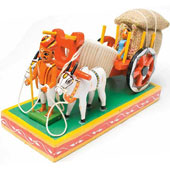Design Resource
Traditional Toys of Kondapalli
The Craft of Wooden Toys
by
J. N. Somya
The popular classical collection of mythological figures include events associated with the life of Lord Krishna, the Gitopadesa, Dasavatars (ten incarnations of Lord Vishnu), representations of Lord Ganesha, Lord Shiva and other gods of the Hindu pantheon. The mythological toys pose a great challenge, as they require skill in portraying half-human and half-animal god figures.
Dastnatar (from left to right) in smallest me paint in natnl colour.
Dasavatar in bigger sizes painted in enamel paints.
Paritrãnãya Sãdhunãm, Vinãshãyashcha Dushkrutãm
Dharma Sansthãpanãthãya Sambhavãmi Yuge Yuge ll
To protect the good, destroy the wicked, establish Dharma or right conduct on earth, I shall be born from age to age (said by Lord Krishna while giving the Gita Updesh to Arjun during the war in Mahabharata).
Amongst the Trinity of Gods, that is, Brahmã, Vishnu and Mahesh; Vishnu who is known as the Preserver of the Universe, seeks from time to time to redeem the world and manifests his Divine Being into the life of man as an Avatãr (Incarnation) whenever evil threatens it. It is said that the ten incarnations represent the evolution of mankind.
The ten incarnations of Vishnu are:
Matsya (The fish)
Kurma (The tortoise)
Varãha (The boar)
Narasimha (The half-man, half-lion)
Vãmana (The dwarf man)
Parshurãm (The man with an axe)
Rãm (The moral man)
Krishnã (The philosophical man)
Balarãma / Buddhã* (The spiritual man)
Kalki (yet to manifest)
*Some texts replace Balarãma to add Buddhã, believing that Balarãma was the incarnation of the serpent (Ananta) on which Vishnu reclined.










